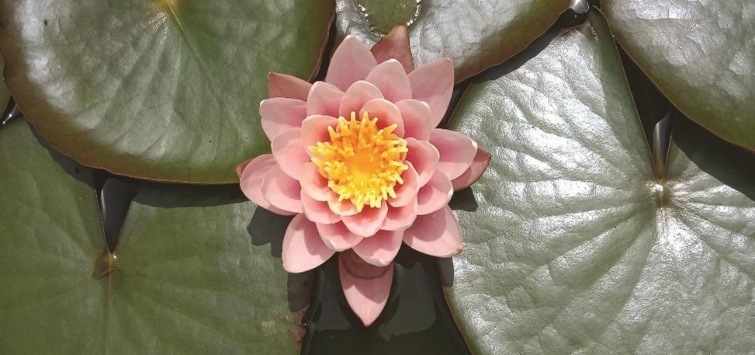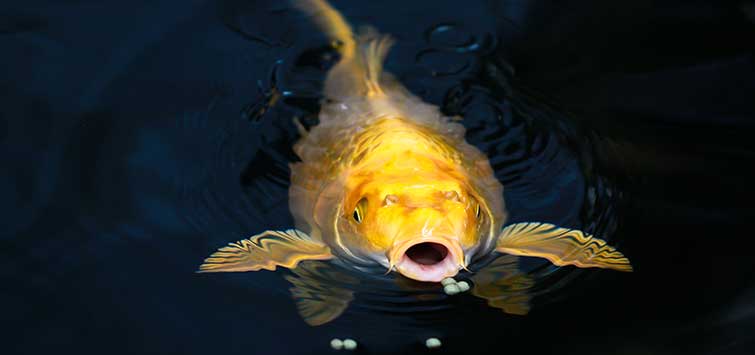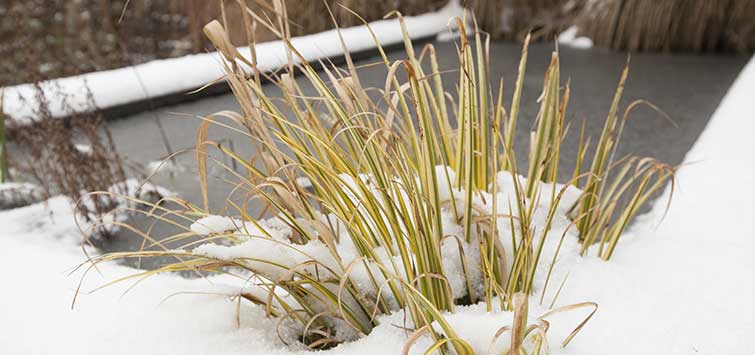Pond Planting Tips: Lilies and Lotuses
I have kept miniature lilies in tubs as small as a bucket in tight spaces to brighten up small courtyards, as well as larger lilies and lotuses in swimming pools that were converted into huge ponds. In the latter, I’ve seen large lilies grow vast rafts of leaves and flaunt a spectacular array of colored flowers after establishing themselves, their green pads creating a lovely contrast against brightly colored goldfish or koi as if in a beautifully rendered painting.
Let’s have a look at the right pond planting method for lilies and lotuses, and how to choose the right ones for your own outdoor paradise.
Water Lilies
Water lilies are by far the most common and iconic of all pond plants. Artists have been capturing images of their round floating leaves and large, colorful star-shaped flowers covering the water’s surface for years. And they provide a wonderful haven for frogs and water insects, cover for fish, and shade from the sun, which reduces algae in your pond.Adding to their popularity is their resiliency, as they are among some of the hardiest plants to grow. They are heavy root feeders, and if allowed to root freely in ponds or wide tubs with a decent gravel base, they will take advantage of any collected mulm, high nitrate, or phosphate in the water and turn these potential problems into beautiful flowers. Water lilies are perennial, growing in warm weather and becoming dormant over cold winters.
Most water lilies are members of the genus Nymphaea, which contains a few dozen species, with a few in related groups. Most of these produce the standard star-shaped flowers about the size of an open palm, give or take depending on factors like maturity and growing conditions, and the wide leaves we call lily pads.
They can loosely be divided into two groups, hardy and tropical water lilies. The obvious difference between them is their temperature sensitivity. Hardy water lilies will survive most winters, while tropical species will not survive extended periods at or near freezing. The roots give a second, less obvious difference. Tropical lilies form from a bulb, while hardy lilies form from a rhizome—a long, subterranean stem from which the plants grow (though this is often discussed and treated like a root, it is really a stem). Because of their temperature sensitivity, tropical water lilies are often regarded as annuals, while hardy water lilies are treated as perennials.
Lilies tend to prefer about 6 to 18 inches (15 to 45 cm) of water above the growing tip (crown) of the rhizome or bulb, though they may adapt to deeper waters as they mature, and they can grow from root stock in the deepest ponds.
Regarding position, always choose an area that gets six or more hours per day of direct summer sun, and at least eight hours is ideal. Lilies will tolerate shade but are unlikely to flower in it.
Lilies only thrive in still water, so plant away from places where splashing, a strong current, or ripples occur. They should not be near fountains, waterfalls, or spillways, for example. Large fish like koi, or even determined birds, may eat soft vegetation or dig up lilies that are not yet established and anchored well.
Starting them in tubs and transplanting them later is helpful. A mesh cage can also be placed over tender new plants to grow out the shoots, making sure that the mesh is wide enough for leaves and flower stems to grow through.
On soil, they are terrific at turning muck into flowers, but if your pond is not well established with a lot of organic matter at the base, or gravel or pebbles to root in, they will struggle. A good pond base consists of a layer of pea- to pebble-sized gravel, full of organic detritus that will usually accumulate naturally. In the early days of an in-ground pond, or a tub setup for a patio or balcony, premade pond soil on top of a gravel base, or fertilizer tabs designed for pond plants or lilies, works well.
If your lilies are growing leaves but not flowering despite good sun and what seems to be reasonable mulm or pond soil, try supplementing with more fertilizer pellets around the root stock. Slow-release fertilizer pellets will provide a longer display, as each flower only blooms for three to five days. Fertilizers should be discontinued once it starts to cool in the fall.
Flower colors of the hardy varieties range from white, pink, red, yellow, and a light orange to apricot. Tropical lilies have flowers that can stand on stalks above the water line, and these come in intense blue, pink, magenta, yellow, white, and dark purple.
Leaf pads of tropical lilies can also have dark streaks and toothed or scalloped edges to create further interest. Some lilies that bloom at night can show deep pinks, reds, white, and stunning blues. Blooms open from dusk and close early or midmorning the next day, depending on weather. These flowers also tend to be more fragrant.
Tips for Growing Hardy Lilies
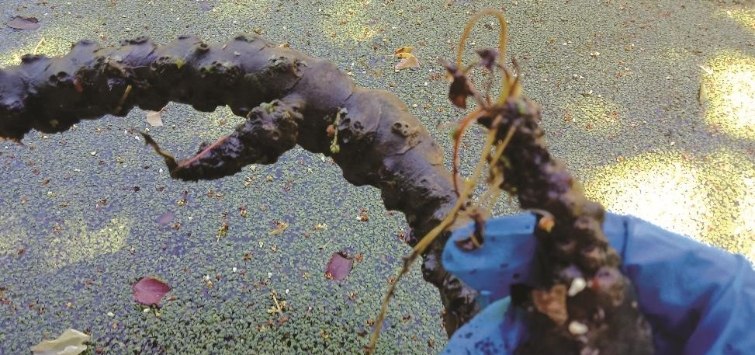
Planting hardy lilies in a natural pond floor when they have sprouted roots and shoots tends to work very well. Plants will sprout in the spring as the water warms, so beginning just before full springtime is perfect. Rhizomes can be clipped from rotten black or mushy roots and other areas and then placed on their side, partially buried, with the growing tip pointing at a slight upward angle. Do not bury the whole thing, as this will cause it to rot. A small stone heavy enough to keep it submerged, but not enough to crush it, can be put on top of the rhizome to hold it in place.
The lily will quickly send out roots to anchor itself as spring progresses. To propagate new pond plantings, dig up a small section of an established rhizome and cleanly cut away a piece about the length of a hand or more with a sharp gardening knife. Avoid pruning shears, as they tend to crush the plant. Repeat the steps above, and you should have lots of lilies in no time!
Tips for Growing Tropical Lilies
With tropical lilies, as they’re often thought of as annuals, the plant is often discarded each fall, and a new one purchased in the spring. This lets you get a variety of water lilies over time, and there’s a certain appeal to annual gardening, but it is a fairly expensive way to go.You can overwinter tropical water lilies in two different ways. The easiest way is to dig them out. Rinse them of any soil or muck, and trim away all the stems, leaves, and roots, so you have just a bare bulb—which is actually a tuber. You’ll often find that there are small offshoots which can be broken off now, allowing you to propagate the plant.
Put the bulbs into a plastic bag wrapped in moist sand or paper towels—they should be damp, not soaked. Treating with fungicide is recommended. Keep them in a cool, dark place, but don’t let them get below about 50°F (10°C). In the spring, they can be replanted.
The other way is to keep them going through the winter. Put the entire pot into a large aquarium or tub with adequate lighting and enjoy it as a winter house plant. Provided it has good overhead lighting, it should survive inside just fine. Keep it pruned and trimmed so it doesn’t take over your aquarium, though. And be cautious putting it back outside, as a sudden change in temperature and lighting condition may shock it.
Lotuses
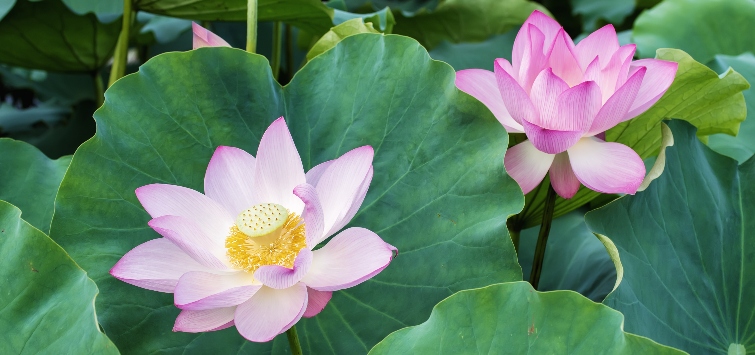
Lotuses have larger leaves and flowers than lilies, and both the leaves and flowers can grow up to 1 foot (30 cm) in diameter. Both are held aloft on stems that rise above the water, which can range from 18 to 60 inches (45 to 150 cm) in length. This is where lotuses can easily be distinguished from water lilies, as lily leaves float on the surface and lotuses usually rise above. Long, submersed stems can reach 6 feet (1.8 cm). Smaller (“dwarf”) variants often have stems of 2 to 4 feet (60 to 120 cm).
For the most part, lotuses and hardy lilies can be grown and treated in similar ways. Both have rhizomes, and these are planted the same way and should be allowed to spread. Lotuses may require richer soil than lilies, as they are larger and so fertilize well with pellets if they are not started with rich or mature pond soil. Fertilizer should be added as needed when actively growing to address nutritional deficiencies. Leaves can take some time to emerge, especially after breaking dormancy in spring, so patience is a must. The initial leaves may float like a lily, but the leaves that follow will be bigger and stronger and start to emerge above the water. For successful flowering, lotuses will need approximately a month of temperatures over 80°F (27°C). They will bloom during daylight hours for several days.
While lotuses generally do best in temperate to tropical zones, some varieties can be hardy in colder climates. Cover or protected areas are good for planting lotuses that will have to deal with cold winters, as it will prevent the worst damage from the elements.
Cut off stems as they begin to die back in the cool months to help the plant into its dormant state. If possible, try lowering in a small aquarium heater somewhere near the root stock to prevent damage from cold snaps or from getting too close to freezing. If ponds are likely to freeze over during winter, and ponds are shallow, rhizomes can be neatly dug up and kept in hessian sacks in a cool dark place, then replanted in early spring. Always check with sellers about your plant variety and your intended pond planting location to get the best advice.
You can also try growing lotuses from seeds collected after flowering. Flowers usually only last a few days, then petals will drop, leaving the seed pod behind. This in itself looks attractive and makes for an unusual addition to cut-flower arrangements. If left to grow and mature, the yellow pod will soon turn green, then brown before its seeds are released. If you are able to shake out and collect seeds from a brown pod before they drop, plant them in rich pond soil in a shallow spot near the surface with plenty of light and you may be surprised by new lotuses growing in short order. To flower well, lotuses also need plenty of sun and a warm temperature, 75° to 87°F (about 24° to 31°C), with eight hours or more of daylight.
Iconic and Beautiful Pond Plants
Lilies and lotuses are without a doubt the most impressive and iconic plants you can choose to have in your pond or water garden. With care in selection of variety, a rich base, and good sun, you should be able to enjoy these beauties all summer long. Happy planting!See the full article on TFH Digital
https://www.tfhdigital.com/tfh/may_jun_2021/MobilePagedReplica.action?pm=2&folio=18#pg21

.png?h=595&iar=0&w=2781&hash=5FD5E69473BCC22199FBFA2FB71B6033)
